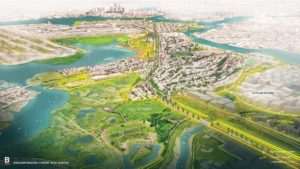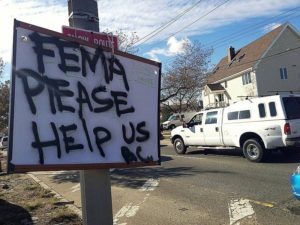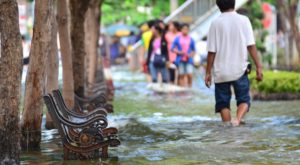This Guest Article for REVITALIZATION was written by Taryn Holowka.
The United States spent $306 billion recovering from natural disasters last year, a record thanks to an unusually large number of hurricanes, wildfires, floods and droughts. No one would suggest that funding full recovery from disasters isn’t important.
But experts and research have shown that more resources should be devoted to disaster preparation to reduce later costs in both blood and treasure.
In short, governments and private developers are smart to plan for crises. Hence the growing movement to make structures in vulnerable communities more resilient through improved preventive action.
Resilience can be defined as the “ability to prepare and plan for, absorb, recover from, and more successfully adapt to adverse events.”
One important aspect of disaster preparedness is proactive design and construction that anticipates potential disasters before construction of structures begin. This can greatly reduce the damage done by natural disasters. California has a multitude of examples such as structures that are built knowing that they can survive an earthquake.
Healthy ecosystems—and restored green infrastructure—are another vital part of resiliency. Floods can be prevented with appropriate land planning ahead of time. Neighboring landscapes to project sites should also be re-imagined and/or restored. Wildfires can easily take hold in dry, uncleared brush. Clearing brush at the time of construction could mitigate fire danger down the road.
The hardest kind of disaster to prepare for is a catastrophic event. These are rare and hard to predict and thus a complete relief plan is difficult to have at the ready. One of the best ways to prepare for the unpredictable is to have a plan to protect—and renovate if needed—the most fundamental parts of infrastructure, especially the power grid. While it is impossible to think of every event that could happen, having a reliable power grid and a well-thought-out back-up power plan is important in any circumstance. Power reliability is essential to disaster relief planning.

Boston’s green infrastructure plan repurposes, renews and reconnects waterfront properties to boost resilience. Image: Resilient Boston Harbor / SCAPE Landscape Architecture.
Case studies in resilience are also useful. The U.S. Green Building Council (USGBC) looked at Boston last year. It worked with E Cubed Optimizers to review the measures taken, lessons learned and challenges facing Boston in its quest to be a truly resilient city.
The study did not start and stop with buildings like many other reliance studies. It also investigated the human side of resiliency and the effect nature itself has on a city’s ability to bounce back after a disaster.
Overall, Boston earned high marks because it recognizes that resiliency is an evolving process requiring continuous improvement to overcome obstacles, adapt to new challenges, improve systems and develop new techniques and approaches. Many cities could learn from the good work Boston has undertaken.
Merely listing the categories that were addressed in the Boston study is instructive for other cities. The categories include waste management, water availability, energy production, transportation, social equity, health and wellness, education, food distribution, regulations, telecommunications and climate adaptation. All of these activities should be taken into account when putting together a comprehensive resiliency plan. The full report is here.
USGBC oversees the leading program that promotes sustainable buildings and communities worldwide: LEED, or Leadership in Energy and Environmental Design. LEED is the most widely used green building rating system in the world. It provides the framework to create healthy, highly efficient and cost-saving buildings.
LEED endorsed practices have been shown to contribute significantly to resiliency. LEED buildings—whether new or retrofitted older structures—save energy, water and resources. They generate less waste and support human health. It also costs less to operate these highly efficient buildings thus making each dollar spent by the owners of greater worth. More important, they tend to be the kind of structures that survive disasters, studies show.
Paying for LEED-endorsed practices and taking other resiliency actions are cost savers, especially in the long run. According to a nonpartisan report commissioned by the Federal Emergency Management Agency (FEMA), federally-funded mitigation grant programs from 1993-2016 generated nearly $158 billion in taxpayer savings.
In a study released this year, the National Institute of Building Sciences found that for every $1 spent on hazard mitigation, $6 is saved in avoided future disaster costs. These are huge potential savings that result from preparing for disasters to happen, not waiting until after they occur.
FEMA Administrator, Brock Long, released the agency’s 2018-2022 Strategic Plan earlier this year. Improving resiliency is a vital part of that strategy. “Resiliency is more than just strengthening our buildings and other infrastructure,” the plan states. “It’s making sure that our citizens have the proper tools and skill sets to reduce the impact of future disasters.”
Lawmakers are also pushing resiliency efforts in Congress. Pending legislation reauthorizing the Federal Aviation Administration (FAA), which was passed by the House of Representatives and has been sent to the Senate, includes two provisions aimed at helping communities limit the impact of natural disasters before they happen.
The House handily approved the provisions, which encourage implementation of cost-saving hazard-and-disaster mitigation efforts at the national, state and local levels. The Senate version of the bill does not have the same provisions, though lawmakers can still add them before the bill is complete and on the President’s desk.
Rather than maintain the status quo that relies primarily on reactive measures after disasters strike, lawmakers appear about to usher in an age of proactive, pre-disaster activities by adopting these provisions.
One of the House-passed measures—the Disaster Recovery Reform Act—would establish dedicated funding for pre-disaster hazard mitigation programs, as part of disaster aid. It would also encourage communities to focus more on preparing for disasters, including implementing better construction standards, such as the LEED green building standard, while allowing them to “build back better” using current codes and standards. This initiative responds to the many instances in which energy-efficient buildings help owners maintain safe building operations during crises.

Residents of Broad Channel, Queens, NY posted a sign pleading for help from FEMA in the wake of Superstorm Sandy. Photo credit: Boss Tweed
The second House-passed provision called the PREPARE Act would authorize an interagency council to recommend the best ways of preparing for extreme weather incidents. The measure would also strengthen federal agencies’ pro-resilience efforts.
In addition, the bill would provide state and local governments with the best information available and best practices to help them formulate emergency preparation plans tailored to their needs.
Without question, federal dollars have been well spent on mitigation efforts in the past. But what Congress chooses to do now with the FAA reauthorization bill will have a profound impact on the ability of hardworking agencies to take precautions in the future.
In fact, spending more on resilience – in private construction and civic planning – is the best way to save not only lives and property but also save taxpayers considerable amounts of money that now go into disaster responses.
About the Author:
 Taryn Holowka is senior vice president of marketing, communications and advocacy for the U.S. Green Building Council. Taryn joined the Council in 2002 and oversees the marketing and communications activities for USGBC and its associated programs. With 15 years of experience, Taryn’s core areas of expertise are strategic communications planning, messaging and brand management. PR News named Taryn PR Professional of the Year in 2008 and she is a PRSA member since 2005. Taryn earned her Masters in Liberal Studies from Georgetown University and her B.A.
Taryn Holowka is senior vice president of marketing, communications and advocacy for the U.S. Green Building Council. Taryn joined the Council in 2002 and oversees the marketing and communications activities for USGBC and its associated programs. With 15 years of experience, Taryn’s core areas of expertise are strategic communications planning, messaging and brand management. PR News named Taryn PR Professional of the Year in 2008 and she is a PRSA member since 2005. Taryn earned her Masters in Liberal Studies from Georgetown University and her B.A.
Taryn holds a Masters in Liberal Studies from Georgetown University and a B.A. in Political Science from the State University of New York College at Geneseo. She has been a LEED AP since 2004. Prior to joining USGBC, Taryn worked at the National Environmental Policy Institute (NEPI) overseeing an EPA grant as part of the Clean Air Act. She also was at the Polyisocyanurate Insulation Manufacturers Association (PIMA).




